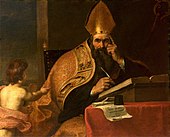| Augustinian Proposal | |
 | |
| Theory Information | |
|---|---|
| Order | Matt Mark Luke |
| Additional Sources | Preaching of Peter |
| Gospels' Sources | |
| Mark | Matt, preaching of Peter |
| Luke | Matt, Mark |
| Theory History | |
| Proponents | Augustine of Hippo |
| |
| Part of a series on |
| Augustine of Hippo |
|---|
 |
| Augustinianism |
| Works |
| Influences and followers |
| Related topics |
| Related categories |
The Augustinian hypothesis (sometimes referred to as the Augustinian Proposal) is a solution to the synoptic problem, which concerns the origin of the Gospels of the New Testament. The hypothesis holds that Matthew was written first, by Matthew the Evangelist (see the Gospel According to the Hebrews and the Jewish-Christian Gospels). Mark the Evangelist wrote the Gospel of Mark second and used Matthew and the preaching of Peter as sources. Luke the Evangelist wrote the Gospel of Luke and was aware of the two Gospels that preceded him. Unlike some competing hypotheses, this hypothesis does not rely on, nor does it argue for, the existence of any document that is not explicitly mentioned in historical testimony. Instead, the hypothesis draws primarily upon historical testimony, rather than textual criticism, as the central line of evidence. The foundation of evidence for the hypothesis is the writings of the Church Fathers: historical sources dating back to as early as the first half of the 2nd century, which have been held as authoritative by most Christians for nearly two millennia. Adherents to the Augustinian hypothesis view it as a simple, coherent solution to the synoptic problem.
Contents
- Origin
- Ancient tradition
- Papias
- Clement
- Irenaeus
- Augustinian revival
- Modern position in detail
- See also
- References
- External links
The Augustinian hypothesis addresses certain fundamental points of contention surrounding the synoptic problem, such as how reliable the early Christian tradition is, which gospel was written first, whether there were other unknown sources behind the gospels, to what extent, if any, the gospels were redacted, and to what extent the gospels were altered between the time they were originally written and the time the first surviving manuscripts appear. These and other matters are raised and alternate resolutions proposed by proponents of competing hypotheses, such as the Two-source hypothesis, its related Q hypothesis, the Farrer hypothesis, and others.
The main two areas of contention within the Augustinian community are whether Matthew was originally written in Aramaic using Hebrew script (see Aramaic primacy), or if the Greek text is the original, and whether it was Mark or Luke who wrote second. A modified version of the Augustinian hypothesis, known as the Griesbach hypothesis, agrees that Matthew wrote first and that Mark depended on Matthew, and does not dispute that the original text was in Hebrew thereafter translated into Greek, but argues that Mark also depended on Luke and therefore that Luke’s gospel precedes Mark's. Because of the similarity on primary points of contention, this hypothesis is also treated as a possible amendment to the Augustinian hypothesis.


